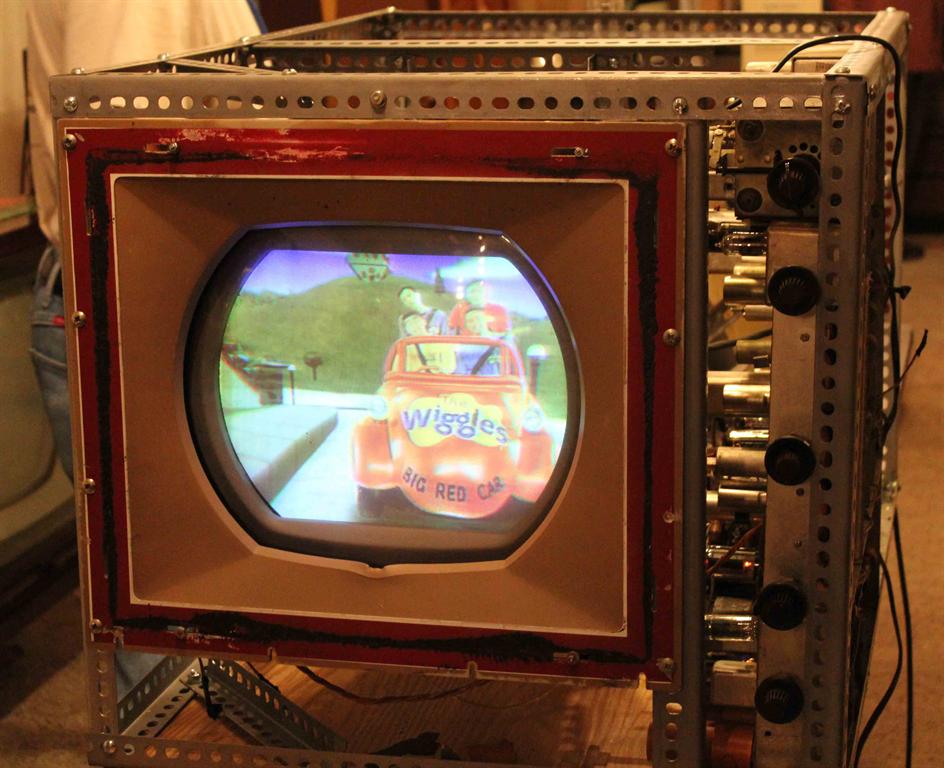Television’s Past Comes Alive at Annual Conference

What is probably the world’s oldest electronic color television receiver was prominently displayed at the 2013 Early Television Conference. It’s seen here operating with signals supplied by a standards converter that outputs the requisite video, complete with 3.89 MHz color subcarrier.
HILLIARD, OHIO—Television history buffs once again flocked to this Columbus, Ohio suburb for the eleventh annual Early Television Foundation conference held May 10-12 this year at the Early Television Museum. The event features a display of restored rare television apparatus, technical presentations, auctions and flea market sales of early television receivers, television-related equipment and ephemera.
According to the conference organizer and Early Television Museum founder, Steve McVoy, the 2013 conference marked yet another attendance milestone for the event.
“Attendance was up again,” said McVoy. “We had 115 this time, up from 108 last year.” This is a record for the conference.”
McVoy noted that attendees traveled from as far away as California, Washington state and Montreal to take part in the activities.
‘CPA’ IS ALIVE AND WELL
One of the big draws at this year’s conference was the fabled RCA “CPA” developmental receiver which was discovered in an eBay auction last year.
“CPA” stands for “color phase alternation,” and the technology—developed and disclosed by both RCA and Hazeltine Labs at about the same time—can be viewed as something of a milestone in the road to NTSC compatible color and the precursor of PAL color.
The existence of the 60+ year-old receiver chassis and developmental tri-color CRT was disclosed at the 2012 conference by its current owner, Nick Williams.
During the past year, a considerable amount of research has taken place concerning both the CPA receiver and the concept itself. Circuitry of the experimental chassis has been traced and a schematic drawing prepared, and from this effort enough information was obtained to allow the receiver—which had been stripped of some components—to be restored to operating condition.
Restoration of the CPA chassis to its original state and repairing it to operational condition were herculean efforts, but would have been for naught, had not a source of video signals been available for this one-of-a-kind television receiver. Another early television enthusiast, Darryl Hock, stepped up to the plate with a modification of his universal television standards conversion to spit out the alternating phase and very high frequency (by later color standards) 3.89 MHz color subcarrier.
The CPA receiver is now fully operational and was placed on display in the center of the Museum’s color television gallery. A specially constructed “cage” or frame allowed visitors to view both the top and bottom of the chassis, as well as to observe a type of video not seen since RCA abandoned the phase alternation scheme around 1952 as too expensive to incorporate in a consumer receiver.
CPA color was also the subject of two papers presented at the conference: “RCA Labs Experience with CPA” by Dr. George Lemaster, and “The RCA CPA Prototype” by Steve McVoy.
Other presentations included a paper by Lee Barmakian on the restoration of the largest black and white direct view television receiver ever built, the 1951 30-inch DuMont “Royal Sovereign” and an overview by Cliff Benham of the reverse engineering and reconstruction of a color wheel motor drive chassis that had gone missing from a DuMont 12.5-inch “industrial” field sequential color television monitor which had been originally displayed at the 1950 IRE Radio Show.
This special Dumont set, which was the subject of Beham’s presentation, has been completely restored and was another attraction at the conference. It displayed 525-line color pictures and used an IF bandwidth of 18 MHz.
According to McVoy, the proceeds from this year’s equipment auction totaled nearly $11,000. The highest value item sold was a 1939 mirror-lid 12-inch RCA “handyman special” set that sold for $7,000.
Dates for the 2014 Early Television Foundation conference have not yet been announced.
Get the TV Tech Newsletter
The professional video industry's #1 source for news, trends and product and tech information. Sign up below.
James E. O’Neal has more than 50 years of experience in the broadcast arena, serving for nearly 37 years as a television broadcast engineer and, following his retirement from that field in 2005, moving into journalism as technology editor for TV Technology for almost the next decade. He continues to provide content for this publication, as well as sister publication Radio World, and others. He authored the chapter on HF shortwave radio for the 11th Edition of the NAB Engineering Handbook, and serves as editor-in-chief of the IEEE’s Broadcast Technology publication, and as associate editor of the SMPTE Motion Imaging Journal. He is a SMPTE Life Fellow, and a Life Member of the IEEE and the SBE.

